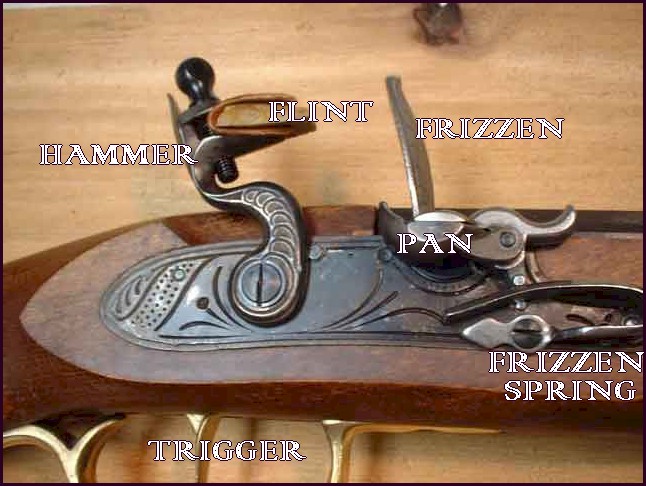The idea behind flint and steel is
straightforward

Flint is an amazingly hard
form of rock. If you strike iron or steel
with flint, the flint flakes off tiny
particles of iron. The force of the blow and
the friction it creates actually ignites the
iron, and it burns rapidly to form Fe3O4.
The sparks that you see are the hot specks
of iron burning! If these sparks come near
gunpowder, they will ignite it.
The flintlock therefore needs:
A piece of flint
A piece of steel
A place for the sparks to touch gunpowder
The flint needs to move at high speed and strike the steel in such a
way that the sparks fall into some gunpowder. You can see the four parts
that make this happen.
The main parts of a flintlock are:
The hammer, which holds and accelerates a piece of flint
The mainspring, which powers the hammer
The frizzen, which is the piece of steel the flint strikes
The pan, which is the place where a small quantity of gunpowder
waits to receive the sparks
These four pieces are all that the flintlock actually needs to
accomplish its goal, but all flintlocks also solve the problems of
loading the pan, protecting the pan from the weather and triggering the
hammer, so there are three additional parts:
The tumbler, which holds and releases the power of the mainspring
and transmits it to the hammer
The sear and sear spring, which engage the tumbler and release it
when someone pulls the trigger
The frizzen spring, which holds the cover attached to the frizzen
over the pan to make the flintlock weatherproof
The mainspring presses against the tumbler and is able to rotate the
hammer with a great deal of force. The sear engages the tumbler when the
gun is cocked and holds the force of the mainspring. When you pull the
trigger, it pushes the sear enough to release the tumbler and allows the
hammer to drive the flint forward.
When you work with a flintlock and watch a flintlock in action you
can see how all of these pieces work together. A flintlock has three
positions for the hammer: un-cocked, half-cocked and fully cocked.
To use a flintlock, you follow these steps:
Half-cock the hammer.
Pour a measure of gunpowder down the barrel.
Wrap a lead ball (the bullet) in a small piece of cloth or paper
and ram it down the barrel on top of the gunpowder. The bullet/cloth
combination will have a nice, tight fit.
Place a small amount of gunpowder in the flintlock's pan.
Snap the frizzen in place over the pan.
Fully cock the hammer.
Pull the trigger to fire the gun.
When you fire the gun, the flint strikes the frizzen and shaves off
iron to create sparks. The hammer's blow also snaps the frizzen back to
expose the gunpowder in the pan. The pan's gunpowder ignites, and it
flashes through a small hole in the side of the barrel to ignite the
gunpowder inside the barrel.
| 
